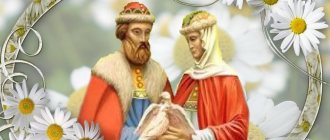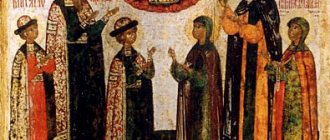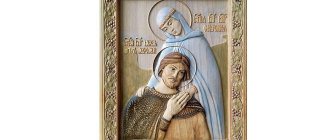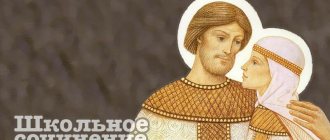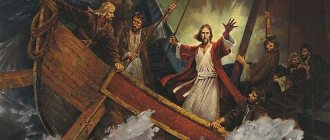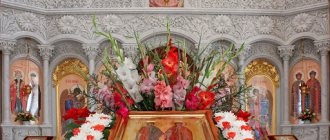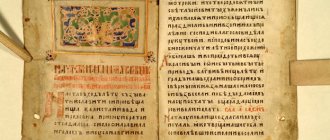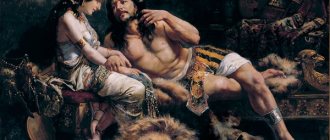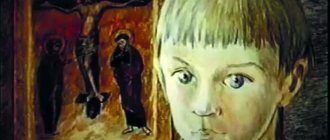- Summary
- /
- Different
- /
- The Tale of Peter and Fevronia of Murom
Leprosy struck Prince Peter of Murom; not a single doctor could help him. Then the healer Fevronia came to him and promised to help if the prince took her as his wife. The prince agreed, but did not want to keep his words and elevate a girl from the people to himself, then he again fell ill with illness.
And Fevronia came to him again with the same conditions, this time Peter married a girl. The boyars did not agree to recognize the unequal marriage and demanded that Peter leave his wife. The couple went to live together on the river bank, where they spent some time until they were begged to return to Murom. They ruled there together for many years, and in their old age they entered a monastery. The prince is in the men's room, Fevronia is in the women's room. They could not see each other, but they died on the same day, after which a miracle happened: the remains of the husband and wife were found lying in the same grave.
The ancient Russian story contains a vivid example, an example of a virtuous, elevated family life. A worthy love that rises above death.
“The Tale of Peter and Fevronia” in abbreviation
I
XII century. Ancient Rus'. Prince Pavel rules the city of Murom. One day the devil sends a winged serpent to Paul's wife. The insidious serpent seduces the woman, and she tells everything to her husband. Paul asks his wife to find out from the serpent what kind of death awaits him. The woman manages to find out that the snake is destined to die “from Peter’s shoulder and from Agrikov’s sword.” Paul tells his brother Peter about the serpent and his words. Brave Peter understands that he must kill the insidious serpent. Miraculously, he finds the same Agrikov sword in the local church. When the serpent reappears in the palace, Peter kills it with Agric's sword. Dying, the serpent splashes Peter with its poisonous blood. Soon the prince's body is covered with ulcers that cannot be cured.
II
Prince Peter and his servants come to Ryazan in search of a good doctor. The servants travel around the area and in the village of Laskovo they meet the girl Fevronia, the daughter of a peasant. Wise Fevronia has the gift of healing. She promises to cure the prince if he marries her. Peter agrees, and Fevronia gives him sourdough ointment. He must apply this ointment to his entire body, except for one ulcer. Peter applies the ointment and immediately feels healthy. The next morning his body is cleared of ulcers, except for that one. The satisfied prince leaves for Murom, without marrying Fevronia. He sends her gifts, but the deceived girl does not accept them. In Murom, Peter's body is again covered with ulcers. He again goes to Fevronia and with shame asks for new healing. The girl does not hold a grudge and promises to cure him if he marries her. The prince gives her his word. Having recovered from the ulcers, he actually marries Fevronia. The couple settles together in Murom, where they live happily.
III
Soon Prince Pavel dies. His brother, Prince Peter, becomes the ruler of Murom. The boyars do not like Princess Fevronia and ask Peter to find himself a more noble wife. Prince Peter loves his wife and appreciates her amazing abilities. He leaves the decision up to her. Fevronia agrees to leave the city, but only with Peter. Then Prince Peter leaves his post and leaves the city together with Fevronia. Peter and Fevronia leave Murom on ships. The next morning, the boyars from Murom catch up with them. They ask Peter and Fevronia to return and rule the city again: after the prince’s departure, a struggle broke out among the boyars and many of them died; now they want the peaceful reign of Peter and Fevronia. The couple return to Murom, where they rule fairly and meekly, keeping all the commandments and doing good deeds.
IV
Years pass, Peter and Fevronia grow old. They ask God that they die at the same time and that they be buried in the same tomb between them. The couple are tonsured as monks and soon die at the same time, as they wished. The townspeople decide to bury Peter and Fevronia separately, since the couple became monks before their death. Coffins with the bodies of the deceased are placed in churches in different parts of the city. In the morning, people see that the spouses’ coffins are empty, and their bodies lie together in a common coffin (Peter and Fevronia prepared it during their lifetime). People again place the deceased in separate coffins, but in the morning their bodies are found together again. Residents decide not to separate the spouses and bury them in a single coffin. Since then, believers have come to the relics of Peter and Fevronia to be healed.
At the end, the author sums up the lives of the heroes: Prince Peter was a kind, honest, courageous man, a faithful husband; he defeated the insidious serpent and suffered terrible torment due to ulcers; Fevronia was a kind and wise woman and had the gift of healing.
Part two
Peter learns that he will be able to get help in the Ryazan land, so he immediately went there.
One of the youths whom Peter sent to search for doctors found a very strange girl in one village. She said very incomprehensible things that had to be explained. The girl introduced herself to him as Fevronia. The boy told her everything why they were here. He told about the prince’s serious illness, and also asked who he could get help from. The girl said to bring the prince to her. And that if he is honest, the illness will leave him.
When they arrived to the girl, she said that she would help the prince herself, but only if he marries her. The prince did not take the girl’s words seriously, but gave his consent.
Fevronia handed him a bowl of kvass, with which he was supposed to anoint all his wounds and scabs in the bathhouse. Only one left untouched.
The prince wanted to test Fevronia's wisdom, so he gave her an impossible task. To which the girl responded in kind.
The disease disappeared after the procedures performed. But the prince decided not to marry a girl without a noble family. So I just decided to thank her with gifts. But she didn't accept them.
When the prince arrived home, the illness soon returned to him. The prince returned to Fevronia, but this time he married her and took her with him to the city of Murom.
A short retelling of “The Tale of Peter and Fevronia”
Prince Pavel ruled in the city of Murom. The devil sent a flying serpent to his wife for fornication. He appeared to her in his own form, but to other people he seemed to be Prince Paul. The princess confessed everything to her husband, but he did not know what to do. He ordered his wife to ask the serpent why death could come to him. The serpent told the princess that his death would be “from Peter’s shoulder, from Agrikov’s sword.”
The prince had a brother named Peter. He began to think about how to kill the serpent, but did not know where to get Agrikov’s sword. Once in the church of the Vozdvizhensky Monastery, a child showed him Agrikov’s sword, which lay in a gap between the stones of the altar wall. The prince took the sword.
One day Peter came to his brother. He was at home, in his room. Then Peter went to his daughter-in-law and saw that his brother was already sitting with her. Paul explained that the serpent can take on his form. Then Peter ordered his brother not to go anywhere, took Agrikov’s sword, came to his daughter-in-law and killed the serpent. The serpent appeared in his nature and, dying, sprinkled Peter with blood.
Peter's body was covered with ulcers, he became seriously ill, and no one could cure him. The patient was brought to Ryazan land and they began to look for doctors there. His servant came to Laskovo. Entering one house, he saw a girl weaving cloth. It was Fevronia, the daughter of a poison dart frog who extracts honey. The young man, seeing the wisdom of the girl, told her about the misfortune that befell his master.
Fevronia replied that she knew a doctor who could cure the prince, and offered to bring Peter to her house. When this was done, Fevronia volunteered to take on the treatment herself if Peter took her as his wife. The prince did not take her words seriously, because he did not consider it possible to marry the poison dart frog’s daughter, but promised to do so if he was healed.
She gave him a vessel of her bread leaven and ordered him to go to the bathhouse and anoint all the ulcers there with leaven, except one. Peter, wanting to test her wisdom, sent her a bunch of flax and ordered her to weave a shirt, ports and a towel from it while he was in the bathhouse. In response, Fevronia sent him a stump of log so that the prince could make a loom out of it during this time. Peter told her that this was impossible. And Fevronia replied that it was also impossible to fulfill his command. Peter marveled at her wisdom.
The next morning he woke up healthy - there was only one ulcer on his body - but did not fulfill his promise to marry Fevronia, but sent her gifts. She didn't accept them. The prince left for the city of Murom, but his ulcers multiplied and he was forced to return to Fevronia in shame. The girl healed the prince, and he took her as his wife.
Pavel died, and Peter began to rule Murom. The boyars did not like Princess Fevronia because of her origin and slandered Petra about her. One person said, for example, that Fevronia, getting up from the table, collects crumbs in her hand as if she were hungry. The prince ordered his wife to dine with him. After dinner, the princess collected crumbs from the table. Peter unclenched her hand and saw incense in it.
Then the boyars directly told the prince that they did not want to see Fevronia as a princess: let him take whatever wealth he wants and leave Murom. They repeated the same thing at Fevronia’s own feast. She agreed, but only wanted to take her husband with her. The prince followed God's commandments and therefore did not part with his wife, although he had to renounce his principality. And the boyars were pleased with this decision, because each of them wanted to be a ruler himself.
Peter and Fevronia sailed out of the city along the Oka. On the ship where Fevronia was, there was another man with his wife. He looked at Fevronia with some thought. And she told him to scoop up water on the right and left sides of the boat and drink. And then she asked which water tastes better. Hearing that she was the same, Fevronia explained: female nature is the same, so there is no point in thinking about someone else’s wife.
Food was prepared on the shore, and the cook cut down small trees to hang the cauldrons on. And Fevronia blessed these trees, and the next morning they became large trees. Peter and Fevronia were planning to move on. But then nobles from Murom came and began to ask the prince and princess to return to rule the city.
Peter and Fevronia, having returned, ruled meekly and fairly.
The couple begged God to die at the same time. They wanted to be buried together and ordered two coffins to be carved in one stone, which had only a partition between them. At the same time, the prince and princess took monasticism. Peter received the monastic name David, and Fevronia became Euphrosyne.
Euphrosyne embroidered air for the temple. And David sent a letter to her: he was waiting for her to die together. The nun asked him to wait until she finished embroidering the air. In the second letter, David wrote that he could not wait long, and in the third, that he could wait no longer. Then Euphrosyne, having finished embroidering the face of the last saint, but not finishing the clothes, sent to tell David that she was ready to die. And after praying, they both died on June 25th.
Their bodies were laid in different places: David - at the Cathedral Church of the Mother of God, and Euphrosyne - in the Vozdvizhensky Convent. And their common coffin, which they themselves ordered to hew, was placed in the Church of the Virgin Mary.
The next morning, their separate coffins were empty, and the bodies of the saints rested “in a single coffin.” People buried them as before. And the next morning they were found again in a common coffin. Then people no longer dared to touch the bodies of the saints and, having fulfilled their will, buried them together in the cathedral church of the Nativity of the Virgin. Those who come to their relics with faith receive healing.
This is interesting: Jacob Chernorizets wrote “The Tale of Boris and Gleb” in the 11th century. This is one of the monuments of ancient Russian literature. A summary of “The Tale of Boris and Gleb” can be read on our website.
Chapter Three
The prince's brother died. Therefore, Peter became the sole ruler. Fevronia was not accepted for the reason that she was not of noble birth. The boyars even offered the prince to take another woman as his wife. And send Fevronia back, giving her as much wealth as she wants. The prince asked them to voice their request to Fevronia herself.
She promised them that she would fulfill their request, but only on the condition that the prince leave with her. The boyars were not very upset, because they had long dreamed of taking his place.
The prince decided to adhere to God's commandments, so he left with Fevronia. When they were crossing the river in ships, one of the men wanted to get closer to Fevronia. But she very wisely gave him a lesson. After this, he realized that she had the gift of foresight.
The prince was saddened that he had made such a hasty decision. But Fevronia reassured him, saying that God would not abandon them in trouble.
In the morning the boyars came to them, begging them to return and continue to rule the city of Murom. It turns out that there were too many people who wanted to become rulers, so they killed each other. Prince Peter and Princess Fevronia agreed to return.
For a long time they ruled without violating God's commandments and helping everyone in need.
Chapter Four
Peter and Fevronia asked God to let them die at the same time. They also asked to make them a coffin made of one stone, with a very thin partition. They became monks and were now called David and Euphrosyne.
When the prince realized that his minutes were numbered, he sent for Fevronia. But she was embroidering an icon and could not come without finishing the work. The prince sent for her three times, but she never managed to finish the embroidery, she just stuck a needle into the ground. They died on the same day, June 25th.
But people did not comply with their request and decided to bury them in different places. When they put together two coffins that stood in different churches. And the coffin that was originally carved for them remained standing in the temple. But in the morning both coffins were empty. And the bodies of the saints ended up together.
But people again decided to separate them, so they moved them separately. But the next morning history repeated itself. Then, finally, people realized that there was no point in trying to separate them.
